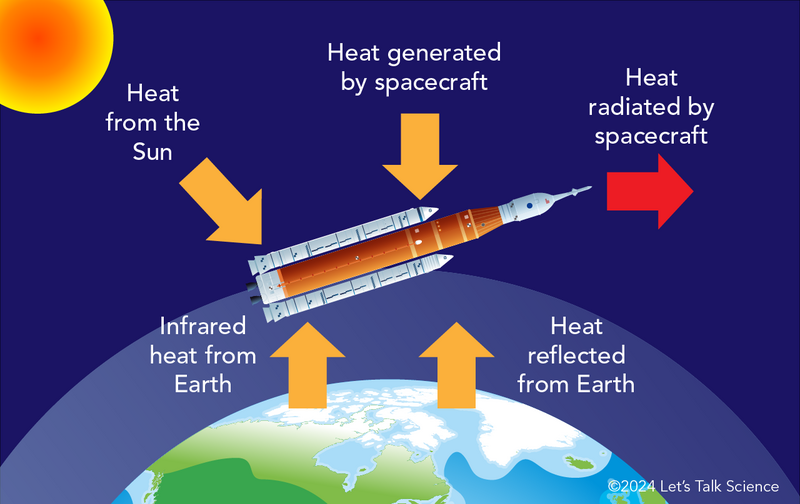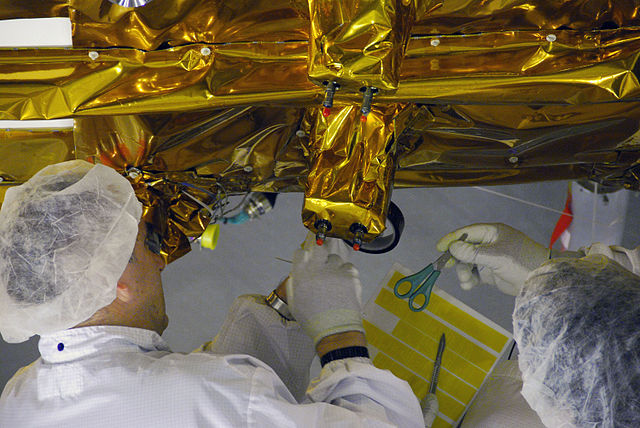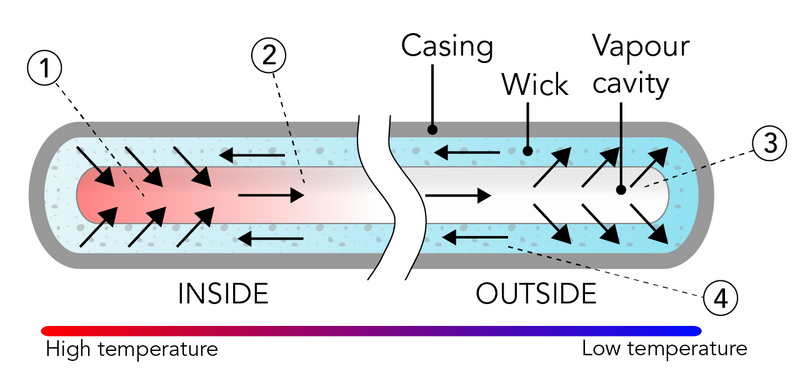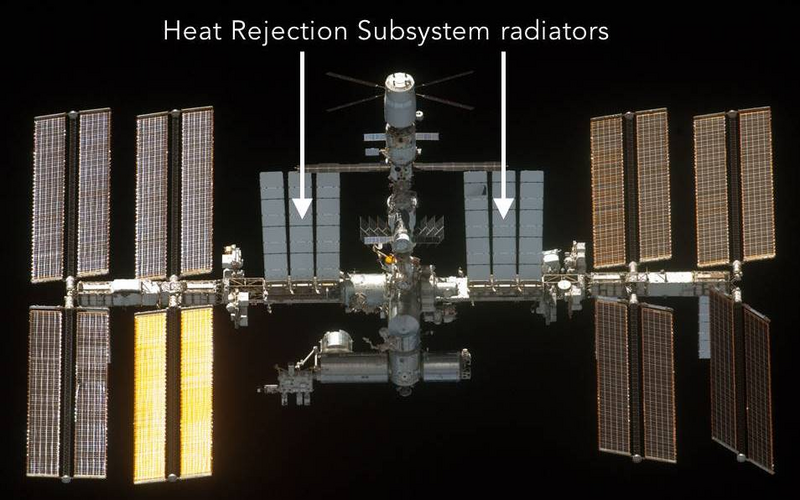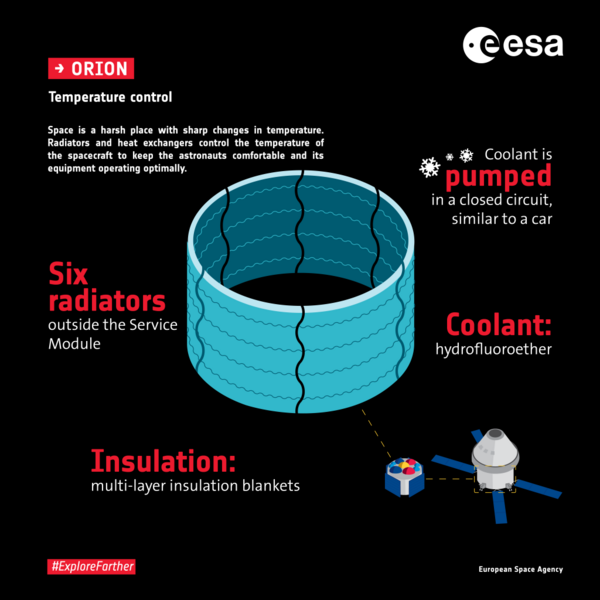Heat and Space Missions
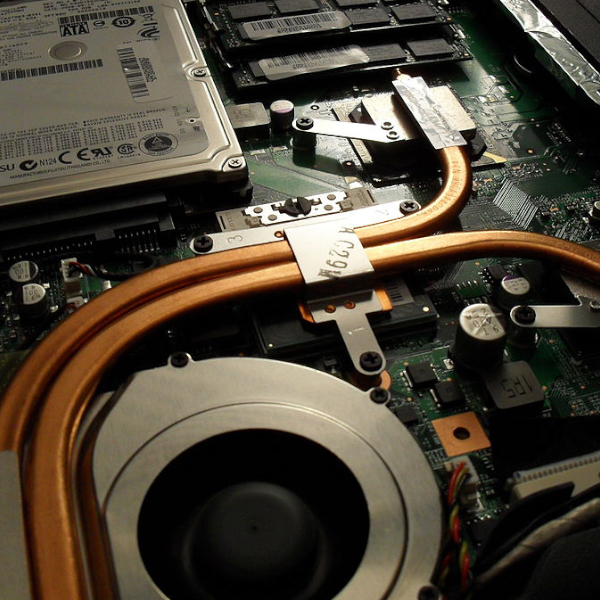
Heat pipe in a laptop (Kristoferb, CC-BY-SA Wikimedia Commons)

Heat pipe in a laptop (Kristoferb, CC-BY-SA Wikimedia Commons)
How does this align with my curriculum?
Learn about how people control heat in spacecraft such as the ISS and Orion.
Heat is important to life on Earth. Plants and animals need heat for such things as growth and reproduction. On Earth, the main source of heat is the Sun. Other sources of heat include the Earth's core and chemical reactions.
The Sun is also an important source of heat in our Solar System. Spacecraft that travel beyond Earth need ways to deal with this heat.
What are the sources of heat in a spacecraft?
A spacecraft orbiting Earth absorbs, reflects, generates and gives off heat. A spacecraft:
- Generates heat from the mechanical parts and people inside
- Absorbs heat from the Sun
- Absorbs infrared radiation from the Earth
- Absorbs heat reflected from the Earth's surface (albedo)
- Radiates heat into space
Image - Text Version
Shown is a colour illustration of a spacecraft orbiting above Earth. The spacecraft is in the centre of the image. It has an orange cylindrical body with two shorter white cylindrical objects attached to it. Below the spacecraft is the blue and green Earth. Surrounding the Earth is a pale blue area that represents Earth's atmosphere. The spacecraft lies on the boundary between the atmosphere and space. Space is a dark blue area that forms the background. In the upper left corner is an orange and yellow sphere that represents the Sun. Arrows that represent heat sources point towards and away from the spacecraft. Two orange arrows point from the Earth to the spacecraft. One is labelled “Infrared heat from Earth” and the other is labelled “Heat reflected from Earth”. Another orange arrow points from the Sun towards the spacecraft. This arrow is labelled “Heat from the Sun”. An orange arrow points from space towards the spacecraft. This arrow is labelled “Heat generated by spacecraft”. The final arrow is red. It points from the spacecraft towards space and is labelled “Heat radiated from spacecraft”.
For example, the International Space Station (ISS) is a spacecraft that orbits Earth near the edge of space. Unlike on Earth, the ISS is not protected by much of Earth's atmosphere. The side of the ISS facing the Sun can get as high as 121 °C. The side facing away from the Sun can get as low as -157 °C. This is a difference of almost 300°C! Humans can't live in temperatures that high or low. So, engineers had to figure out how to manage the temperature inside of the ISS.
How do people control heat within spacecraft?
Spacecraft have different types of temperature control systems. Some of these are passive. This means that they do not need energy to control the temperature. Others are active. This means that they need energy to control the temperature.
On the ISS, the Temperature and Humidity Control (THC) subsystem is responsible for air temperature and heat removal. The THC is one part of the Environmental Control and Life Support System (ECLS).
The Passive Thermal Control System is an important part of the THC. Its main function is insulation. Insulation helps keep heat from entering and leaving the ISS. Most of the ISS is coated with insulation called Multi-Layer Insulation (MLI). MLI is made of layers of Mylar® and Kapton. The MLI protects astronauts from extreme temperatures and cosmic radiation.
Did you know?
Mylar® and Kapton are also used in thermal blankets on Earth.
Image - Text Version
Shown is a colour photograph of two people working on a large object wrapped in shiny gold material. Both people are wearing white overalls, hairnets and gloves. One is reaching both hands under a cylinder extending from the object. The other is handing them a pair of scissors. The whole structure they are working on is covered in a thin, bright gold material that looks a bit like tinfoil.
Engineers have also developed special paints, coatings and tapes for the outside of the ISS. These help reflect energy from the Sun and Earth. They also let excess heat escape from the ISS into space.
Both astronauts and electronic devices generate heat. Some of this heat must be sent outside the station. This keeps the temperature inside comfortable. Heat pipes help do that.
Heat pipes are sealed pipes that hold a liquid much like a heat pump. The pipes on the ISS have ammonia because it turns to a vapour at -33.34 ℃. Let's see how it works.
- One end of the pipe is inside the station. When the inside end gets warm, ammonia in the vapour cavity changes from a liquid to a gas.
- The gas travels along the cavity to the outside end.
- Here it condenses back into a liquid, releasing its heat into space.
- The liquid passes through the cavity into a wick that wraps around the cavity. The liquid travels along a wick towards the inside end and starts the cycle again.
Image - Text Version
Shown is a colour illustration of the parts inside a long, sealed pipe. The left end of the pipe is labelled “Inside.” The right end is labelled “Outside.” A white, wavy line illustrates more space between the two. Below the pipe, a scale goes from red on the left, labelled “High Temperature,” to blue on the right, labelled “Low Temperature.” Inside the pipe, a smaller cavity is surrounded by a pale blue material, dotted with grey. This is labelled “Vapour cavity.” The blue area around it is labelled “Wick.” The grey outside layer of the pipe is labelled “Casing.” The inner cavity is pink at the warm, inside end and grey at the right, cooler end. Black arrows point from the warm end of the wick to the cavity inside it. These are labelled “1.” More black arrows point from the warm end of the cavity toward the cooler end. These are labelled “2.” At the cool end, black arrows point from the cavity, out to the wick. These are labelled “3.” From the cool end of the wick, arrows point back to the warm end. These are labelled “4.”
Did you know?
Most laptops contain heat pipes. They are found between the processor and the fan.
Sometimes passive methods are not enough. This is when engineers use active systems. On this ISS this is the Active Thermal Control System (ATCS). The ATCS has three subsystems:
- A subsystem for heat collection.
- A subsystem for heat transportation.
- A subsystem for heat rejection.
In the ATCS heat is transferred to water that is pumped through sealed loops inside the ISS. The water transports heat to another set of sealed loops. These loops are filled with ammonia. Like the heat pipes, these transport the heat to radiators. The radiators are part of the Heat Rejection Subsystem (HRS). The radiators transfer the heat into space. The radiators are the two sets of light-coloured panels outside the ISS near the crew modules.
Image - Text Version
Shown is a colour photograph of the structures on the outside of the ISS, with arrows pointing to two large grey panels near the centre. Horizontal across the centre of the image is a long, silver structure made up of different cylinders connected end-to-end. Another, shorter structure like the first, crosses vertically through the centre. Four pairs of large solar panels are mounted on each end of the horizontal structure. In between these, on either side of the vertical structure, are two grey panels a bit smaller than the solar panels. These are made of a grid of connected grey rectangles. Both these structures are labelled “Heat Rejection Subsystem radiators,” with white arrows.
Another important part of controlling temperature is moving the air around the ISS. The THC makes sure that the crew areas have good ventilation. This prevents cold spots in the station. Cold spots can lead to condensation, corrosion, or even fungi growing in the ISS.
What about missions beyond Earth?
The Orion spacecraft will carry humans to the Moon as part of the Artemis program. Like the ISS it will have both active and passive systems. The passive systems include heaters and MLI thermal blankets. The active systems include a fluid system that will circulate a cooling fluid. It will have cold plates near electronics that will draw heat away from them. Finally, it will have 6 radiators that will remove heat from the spacecraft.
Image - Text Version
Shown is a colour illustration that highlights important aspects of the temperature control system on the Orion spacecraft. The European Space Agency logo is on the top right, across from the title, “Orion Temperature Control.” Text below reads. “Space is a harsh place with sharp changes in temperature. Radiators and heat exchangers control the temperature of the spacecraft to keep the astronauts comfortable and its equipment operating optimally.” Below is a large blue cylinder on a black background. This represents a specific segment of the Orion capsule. It is marked with thin, wavy blue horizontal lines and thicker, wavy black vertical lines around the inside and outside. Text around the cylinders reads, “Six radiators outside the service module. Insulation: multi-layer insulation blankets. Coolant: Hydrofluoroether. Coolant is pumped, similar to a car.” Below the cylinder, a dotted yellow line connects to a very small grey cylinder with a blue casing around it and brightly coloured dots on top. This indicates where the blue part is located on the overall capsule Another dotted line connects to a grey cylindrical spacecraft with a grey conical top and long blue panels extending from the bottom. This is an overall image of the capsule.
Information in this backgrounder is part of the Living Space Action Project.
Learn More
Introduction to Heat Transfer (2021)
This backgrounder by Let's Talk Science describes the three methods that heat is transferred.
Heat: Indoors and Outdoors (2024)
This backgrounder by Let's Talk Science explores the importance of heat, its sources and how people control it indoors.
References
Boeing. (2021). Active Thermal Control System (ATCS) Overview. IDS Business Support, Communications and Community Affairs.
European Space Agency. (n.d.). Temperature Control.
European Space Agency. (2023, Feb. 3). How to fly Orion: Thermal
NASA. (2024). State-of-the-Art of Small Spacecraft Technology. Chapter 7. Thermal Controls.
Tara, R. (2023, Sept. 1). What Makes Heat Pipes So Cool? Space Station Experiments May Reveal the Secret. Engineering.com.
Gentry, G. J. & Cover, J. (2015). The National Aeronautics & Space Administration, Houston, Texas International Space Station (ISS) Environmental Control and Life Support (ECLS) System Overview of Events: 2010 - 2014. 45th International Conference on Environmental Systems, July 2015, Bellevue, Washington.
Van Wagenen, R. (2020, Jan. 13). The ISS Engineering Feat: Power and Cooling. ISS National Laboratory.
Wikipedia. (n.d.). Spacecraft thermal control.
